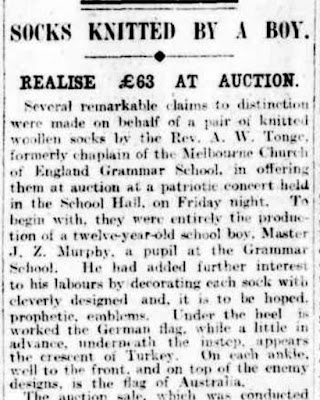This is an account of the first Anzac Day, held after the War ended, at Nar Nar Goon North. There were actually few local accounts in the papers of Anzac Day events, so they either weren't reported on or communities didn't hold events. There were still 'Welcome Home' functions being held in 1919, so perhaps locals concentrated on those events.
Pakenham Gazette May 2, 1919.
Anzac Day was celebrated in the local State School on Tuesday afternoon in the presence of the parents and friends of the children. Mr Prior, who acted as chairman, spoke of the great sacrifice made for us by the soldiers and the need for us to make ourselves more worthy of those sacrifices.
After reading the names on the school Honor Roll, Mr Prior introduced Sergeant Swindells, M.M., one of four soldier brothers, three of whom took place in the landing.
Sergeant Swindells briefly described the part taken by his battalion from the day of the landing until after the 9th of August 1918. His speech was particularly interesting to those present as several boys well known in this district were in the same battallion - the seventh. Among them were Harry Warner, Robert Black, Dave Dore and Higham Pepper, the last three being in the same company as Sgt. Swindells, who in concluding, paid a tribute to the soldiers qualities and ability as a machine-gunner of the late Lance-corporal H. Pepper, who met his death in trying to put a German machine gun, that was working havoc among the Australians, out of action.
The programme of patriotic songs and recitations was then continued, and after the saluting of the flag the proceedings terminated with the National Anthem and three cheers for the Anzacs.
Here is some more detail on the soldiers listed - SN is Service Number. You can see their full record on the National Archives of Australia website,
www.naa.gov.au
Black, Robert Livingstone Conning (SN 5985) was a 22 year old Engineering student, who enlisted on February 2, 1916. Robert was Killed in Action in France on August 9, 1918. Robert was the son of Thomas Montgomery Black and Margaret Ellen Fergus, orchardists of Pakenham Upper. Robert's brothers also enlisted, you can read about them,
here.
Dore, David (SN 2637a) David was born at Nar Nar Goon and when he enlisted on July 20, 1915 his next of kin was his uncle, Mr J, Dore of Nar Nar Goon. He was 18 years old and was an orphan. He was Killed in Action in France on August 9, 1918. David is listed on both the Nar Nar Goon Honour Roll and the Nar Nar Goon North State School Honour Roll. See my post on these Honour Rolls,
here.
Pepper, Harry Higham (SN 2744) Higham, as he was apparently called, enlisted on August 2, 1915, his next of kin was his mother, Mary Ann Pepper of Nar Nar Goon and his occupation was farmer. He was Killed in Action in France on August 9, 1918. Higham is listed on the Nar Nar Goon Honour Roll, see
here.
Swindells, Ronald (SN 1182) Sergeant Swindells enlisted on September 22, 1914 at the age of 19. His next of kin was his mother, Annie, who lived at 18 Peers Street, West Richmond and later at 117 Tinning Street, Brunswick. He Returned to Australia October 13, 1918. As mentioned in the article, Ronald's three brothers also enlisted - Norman, Raymond and Willie.
Warner, Charles Henry (SN 7081) Harry, as he was known, was 30 when he enlisted on October 19, 1916. He was a farmer and his next of kin was his father, Andrew, of Pakenham Upper. In September 1917 he was shot in the chest by a machine gun bullet and embarked for Australia, after treatment, on January 11 1918. He died on March 9, 1918. Harry was amongst a group of 'fallen soldiers' whose families received a certificate at a Welcome Home held at the Pakenham Upper Hall, on June 19, 1918, read about this,
here.














